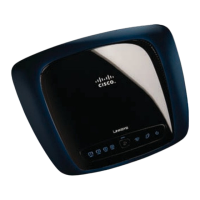
Do you have a question about the Linksys WRT400N and is the answer not in the manual?
| operating temperature | 32 to 104°F (0 to 40°C) |
|---|---|
| storage temperature | -4 to 158°F (-20 to 70°C) |
| operating humidity | 10 to 85%, Noncondensing |
| power | 12V, 1.5A |
|---|---|
| ports | Power, Ethernet, Internet |
| button | Reset, Wi-Fi Protected Setup |
| standards | Draft 802.11n, 802.11a, 802.11g, 802.11b, 802.3, 802.3u |
|---|---|
| modulations | 802.11b: CCK, QPSK, BPSK; 802.11g: OFDM; 802.11a: OFDM; Wireless-N: BPSK, QPSK, 16-QAM, 64-QAM |
| streams | Two Spatial Streams for Transmitting and Receiving in 2.4 GHz and 5 GHz Radio Band |
| security features | WEP, WPA, WPA2 |
|---|---|
| wep key bits | Up to 128-Bit Encryption |
| receive sensitivity 2.4GHz | 11Mbps: -88 dBm @ Typical, 54Mbps: -72 dBm @ Typical, MCS15 (20MHz): -68 dBm @ Typical, MCS15 (40MHz): -65 dBm @ Typical |
| dimensions | 8.07" x 1.38" x 6.30" (205 x 35 x 160 mm) |
|---|---|
| weight | 1.01 lb (460 g) |
| number of antennas | 4 Total, 2 Internal Antennas per Each 2.4 GHz & 5 GHz Radio Band |
Explains icons used in the guide for quick reference.
Lists website addresses for support, glossary, and security information.
Details the router's front panel LEDs/buttons and back panel ports/reset button.
Provides instructions for horizontal and wall-mounting the router.
Covers changing SSID/password, MAC filtering, and encryption for network security.
Provides guidelines for overall network security and physical placement advice.
Guides users on accessing the router's configuration interface via a web browser.
Covers router's general settings, language, and various internet connection types.
Details network configuration, DHCP server settings, and IP address reservation.
Covers time zone, Dynamic DNS, and MAC address cloning configurations.
Explains static routing configuration and network address settings.
Configures fundamental wireless network settings for 2.4 GHz and 5 GHz bands.
Provides methods for configuring wireless security using WPS for client devices.
Explains WPA, WPA2, RADIUS, and WEP security modes for wireless networks.
Allows filtering wireless users by MAC address, permitting or blocking access.
Covers advanced wireless functions like AP Isolation, authentication, and transmission rates.
Configures firewall rules and enables VPN tunnels (IPSec, PPTP, L2TP) through the router.
Manages access policies to deny or allow specific internet usage by day and time.
Customizes port services for applications and public services like web servers.
Manages port triggering and exposes a computer via DMZ for specific services.
Prioritizes network traffic for demanding applications like voice and video.
Manages router functions, security, passwords, and remote access settings.
Monitors network traffic logs and performs diagnostic tests like Ping and Traceroute.
Restores router settings to factory defaults and updates the router's firmware.
Displays current status of the router, local network, and wireless networks.